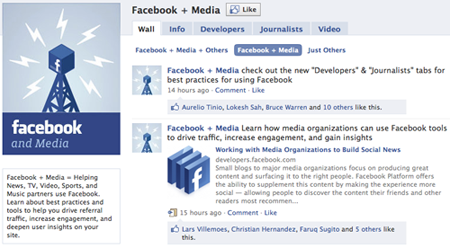
Last night, Facebook unveiled a project that it’s had in the works for a while: a media page devoted to journalists, developers, and other “media partners.” Facebook + Media is dedicated, it says, to “helping news, TV, video, sports, and music partners use Facebook” — in particular, by helping them “learn about best practices and tools to help…drive referral traffic, increase engagement, and deepen user insights.”
The page offers data, for example, into how users engage with news content shared on Facebook — think of it as the social sister to Google Analytics. For example, per a note we received from a Facebook spokesperson, and based on a study of the 100 top media sites that integrate the network’s social plugins:
– Stories published in the early morning or late evening showed higher engagement
– Websites experienced 3-5x greater click-through rates on the Like button when they included thumbnail photos of a user’s friends, enabled users to add comments (which 70% of top performing sites did), and placed the Like button at the top and bottom of articles and near visually exciting content like videos and graphics Sites that place Facebook social plugins above the fold and on multiple webpages receive more engagement. For example, sites that placed the Activity Feed plugin on the front and content pages received 2-10x more clicks per user than sites with the plugins on the front page alone.
– Sites have used the Live Stream box to boost engagement with live video content. During the World Cup, there were over 1.5 million status updates through the Live Stream box on media websites such as Univision, TF1, ESPN, Cuatro, RTVE, and Telecinco.
Whatever your current engagement with Facebook, and whether your particular news organization is staffed by 1,000 employees or one, the findings are worth attention. Here’s some more information on the data and how it was assembled.
As far as Facebook itself is concerned, the new page seems devoted not just to data on traffic and interactivity and the like, but also to avoiding the trap that Google has found itself in and is now trying to rectify: an uncomfortable kind of awkward often oppositional relationship with news organizations. News outlets and social news platforms — or, more clinically, content providers and content distributors — used to be an us-and-them proposition. Now, though, we’re coming to a point where “social news” is not only common, but a redundancy. How could the news, we increasingly assume, be anything but social in nature?
It may have PR overtones; still, Facebook + Media is an indication of the collapse of the wall that used to divide content and delivery platform. As Facebook Development team lead Justin Osofsky — who oversees the company’s media partnerships, and who (with fellow Facebooker Matt Kelly) was on hand at a San Francisco Hacks/Hackers event last night — put it: Facebook is trying to enter into dialogue with journalism organizations. And the media page is “the first cut to start the discussion.”